
Municipalities can increase economic vitality by identifying potential financial tools to assist existing businesses and catalyze new business development.
How it Works
Municipalities can increase economic vitality by working with local business organizations and financial institutions to identify potential financial tools to assist existing businesses and catalyze new business development. Small businesses may not be eligible for more traditional financial programs or large loans and/or require additional opportunities to start up or make improvements. Creating additional local opportunities for "gap" financing can be essential toward maintaining and enhancing a vital main street business environment.
Municipalities can also support the growth of existing businesses and catalyze development and new businesses by providing supporting infrastructure. This can include streetscaping that provides an attractive environment for patrons, and water and sewer capacity that can be essential for restaurants or breweries. Road improvements and adequate parking (public parking, on-street parking, and parking management) are other critical infrastructure for main street success.
Municipal regulations that direct development and do not overtly hinder businesses is important toward achieving sustained economic vitality. A municipality should evaluate its regulations, codes, and processes to ensure they are not impeding the vitality of main street business or hindering appropriate new development. Zoning ordinances, subdivision and land development ordinances, historic resource requirements, special permits, and design guidelines should be examined to determine how they can encourage new business. Prohibiting or limiting uses, excessive or inflexible parking requirements, and unclear, expensive, complicated, or lengthy review and approval processes can all add costs or hinder businesses vitality.
Providing organizational support via "green tape" policies that support and encourage the business community can have a significant positive impact on business retention and attraction. Expediting review process for permits or reduced fees for smaller projects can positively impact small businesses. Cultivating a proactive and flexible approach to changing business and market conditions is very important in volatile economic times, such as recessions or pandemics.
Economic vitality is a key component of a main street program, along with design, promotion, and organization.
Benefits
Business Attraction and Retention
A vital main street is an icon of a healthy community, and a foundation for economic health, local quality of life, and community pride. These are all factors in industrial, commercial, and professional recruitment.
Small and Minority Business Growth
A main street can serve as an incubator for start-up small businesses, the building blocks of healthy economy.
Job Creation
A strong main street retains and creates jobs.
Tax Revenue
A vital main street will generate tax revenue through income and sales tax. Long-term revitalization establishes and supports businesses that use fewer public services and provide significant and sustained tax revenues for the community.
Increased Property Values
A healthy main street core protects property values along the main street and in surrounding neighborhoods.

Allowing for temporary uses such as special events, pop up uses, outdoor dining, food trucks, and farmers markets can bring increased vitality.
Get Started
Economic vitality for main streets requires a myriad of tools. A municipality may wish to form a committee or assign responsibility to an existing committee or organization (Main Street Organization or Business Improvement District—BID) to vet potential initiatives, formulate a strategy, and determine priorities, timing, and responsibilities. The municipal comprehensive plan, revitalization plan, or economic development plan should be referenced for background information and as a guide for economic vitality.
A set of strategies and priorities to enhance economic vitality may include the following:
- Provide financial incentives to businesses to encourage new small business and local entrepreneurs. A municipality should work with local business organizations and financial institutions to identify potential financial tools to assist existing businesses and catalyze new business development. Examples include:
- Revolving loan funds can be set up by a municipality in partnership with a local financial institution. The funds are structured to be a self-replenishing pool of money, utilizing interest and principal payments on old loans in order to issue new ones. These loans are typically for small businesses and for smaller (capped) amounts sometimes called "gap financing" for small businesses that are not eligible for or not able to secure larger conventional loans or lines of credit. Revolving loans are typically tied to certain criteria such as building improvements, equipment, inventory, and working capital, and are not for payroll.
- LERTA. Local Economic Revitalization Tax Assistance is a locally designated area where businesses can defer taxes on new improvements over a specified time period. The purpose is to encourage economic development by allowing property owners within the area to continue paying the property's current taxes for a set amount of time, rather than immediately start to pay the increased tax that would result from new construction and improvements.
- Façade grants assist businesses directly by providing funding for physical improvements. Façade grants can stimulate private investment in properties, foster an attractive environment, and preserve the architectural heritage of properties and communities. Such grant funds are typically used for exterior building improvements such as storefront signs, exterior façade painting, and design assistance in a defined target area of a downtown or neighborhood.
- Business training. Municipalities, in coordination with other stakeholders, can facilitate training opportunities with partners such as the Service Core of Retired Executives (SCORE), financial institutions, or chambers of commerce. Individual or group meetings in addition to workshops, webinars, roundtables, or mentoring sessions can be held at a municipal building, library, or other venue. Information sharing and training through these and other events, email groups, and online applications (Zoom webinar, etc.) are all additional opportunities.
- Tax Increment Finance District
- Tax Increment Financing (TIF) creates special districts around targeted areas from which future tax revenues are diverted to finance infrastructure improvements and/or development.
- At the beginning of the TIF period, tax revenues in the TIF district are frozen at a specific rate. All additional tax revenues go toward directly funding new development or servicing debts related to new development until the end of the TIF period, which is set for a certain number of years (typically 10 to 20 years).
- TIF can typically only be used in areas officially designated as "blighted" and can fund developments ranging from roadway improvements, environmental projects (such as stormwater), construction for approved business or manufacturing projects, or construction of affordable housing. The Pennsylvania Department of Community and Economic Development TIF Guarantee Program supports local TIF bonds.
- Enhance economic vitality through infrastructure improvements such as sidewalks and streetscapes, water and sewer capacity, wifi/internet access, and accessibility to public transit. Municipalities should identify needs and priorities, including designating target locations for improvements through municipal comprehensive or revitalization plans. Such planning can improve opportunities for receiving outside funding and provide justification for applications. Municipalities can seek grants from local, state, and federal sources in addition to foundations and other private sources for the improvement of infrastructure. Infrastructure improvements such as streetscapes provide an attractive business environment. Inadequate public water systems can limit water pressure, which can create hidden costs for business having to pay for supplemental pumps, or limit capacity for business expansion. Internet and wifi access can help a business remain flexible and competitive in volatile market conditions. Maintaining adequate public infrastructure of all types is key to a vital main street.
- Evaluate and modify zoning requirements to:
- Offer a greater range of permitted uses along main streets, provide bonuses for increased building height, relax or create flexible parking requirements, and increase impervious coverage limits in exchange for identified amenities. Such changes can promote business attraction and retention.
- Permit sought-after uses by-right as opposed to conditional use or special exception, which are often time consuming and costly processes.
- Permit and encourage mixed-uses, such as residential units above commercial uses. Encouraging residents along a main street increases vitality and adds "walking wallets" to the community.
- Evaluate and modify area and bulk requirements (setbacks, building widths, etc.) and design standards to be appropriate for and consistent with the main street. Inappropriate zoning requirements can lead to nonconformities and the need for variances, which cost time and money. Restrictive regulations may unwittingly discourage new development or cause issues when a change in use is proposed.
- Review parking requirements and allow flexibility for off-street parking. In many cases off-street parking requirements are prohibitively high for a main street use. Off-street parking spaces take up precious land in higher density main street areas and are costly to construct. Unnecessarily high off-street parking requirements can cause issues when there is a proposed change of use or new use. New development can struggle with finding the physical space for off-street parking, and the cost of off-street parking is then passed down in the form of higher rent or purchase price. Reducing off-street parking requirements to contemporary standards for urban or main street areas, in addition to providing for flexibility through shared parking, parking structures, counting on-street parking, reductions for proximity to public transit, and fee-in-lieu of parking, should all be considered. In conjunction with requirements, the management of off-street parking can be as or more important than the number of spaces available. Parking meters (cost, timing), parking permits, parking restrictions (time, residential areas), and enforcement are all aspects of parking management. The management of parking is important both for businesses and patrons.
- Reduce the "red tape" of codes and regulations to speed up permit approval for businesses as "time is money." Review zoning ordinances to permit sought-after uses by-right rather than conditional use or special exception. Supplemental use requirements can be used to impose any needed criteria by individual use. Review subdivision and land development processes for clarity and consider "fast tracking" applications where only minor changes are required or for smaller/less complicated projects. Review other processes and fees, such as sign permits, zoning permits, and land development processes. Criteria can be set to allow for expedited review procedures and decreased fees.
- Allow for temporary uses such as special events, pop up uses, outdoor dining, food trucks, and farmers markets. Such uses can bring new patrons to a main street or test out concepts with limited up-front costs. Municipalities should limit the regulation of temporary uses in zoning and consider regulation by the municipal code, a stand-alone ordinance, or by administrative permit. Such regulation would reduce the time and cost associated with getting these uses up and running. Since temporary uses evolve, limiting the involvement of the zoning ordinance would make it easier and more cost effective for municipalities to adapt requirements and simpler for any applicants.
- Partner with regional organizations such as chambers of commerce and the Chester County Economic Development Council to increase marketing capacity or conduct other business attraction and marketing activities. See the Main Streets—Promotion etool for additional information.
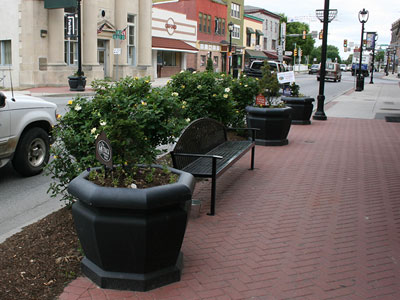
Infrastructure improvements such as streetscapes provide an attractive business environment.
Considerations
Organization
Creating an organizational structure is essential to creating capacity to prioritize efforts and carry out tasks for economic vitality efforts. Such organization can be through a municipal committee or assigning responsibility to an external organization such as a main street organization. Having a process and entity in place is also critical to making progress in a unified manner.
Transparency
Municipalities should involve the business community and residents through a transparent process when developing plans, priorities, and regulations. New or adjusted regulations, codes, or permits should be done through a transparent process involving appropriate stakeholders including both the business community and residents. Advertisement for meetings and hearings should be over and above the minimum legal requirements. This can catalyze a community through a transparent and inclusive process, and minimize future adjustment of adopted measures or potential backlash from businesses or residents if they feel they did not have opportunities for input into or knowledge of the process.
Historic and Architectural Compatibility
Municipalities should strive to balance business support and compatibility with existing main street development and architecture. Exterior design guidelines and consultation with the municipal historic committee or council should be encouraged as a first step for development located in historic areas to ensure it is consistent with the historical fabric.
Small Business Needs
Small and entrepreneurial businesses may lack a full range of business knowledge and connections. Municipalities may need to help businesses with awareness regarding zoning and regulatory requirements, or partner with training organizations to help ensure small businesses are set up to succeed. The lack of capital and connections may be especially significant for minority and women owned businesses. Municipalities may want to consider additional initiatives and policies for supporting these businesses.
Building Challenges
The older buildings common to main streets can pose difficulties for reuse by modern businesses. Municipalities may need to work through challenges with business owners, potentially by providing regulatory flexibility and financial support (façade grants, etc.). See the Adaptive Reuse etool.
Disaster Recovery
The small businesses prevalent on main streets often operate on small margins. As seen during the COVID-19 pandemic and prior disasters such as flooding, small main street businesses may be less able to survive a disaster. Municipalities should include forms of support for main street businesses in their hazard mitigation and disaster planning efforts.
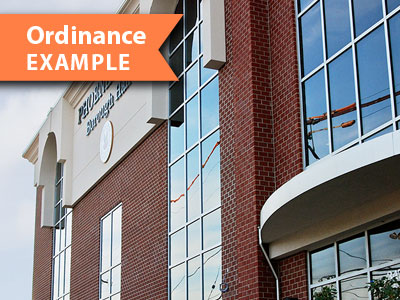
Phoenixville Form Based Codes, no parking requirements for Bridge Street: No additional off-street parking is required for certain blocks as per §27-405.4.
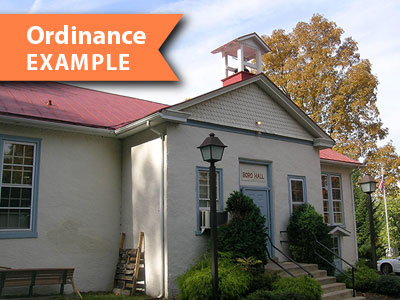
Elverson Borough
Off-street parking requirements for the Town Center District were updated with an entirely new ordinance in 2018. Parking requirement modifications are more reasonable and flexibility was added through various means such as shared parking, reserved parking, fee-in-lieu, and a means of reducing parking requirements if proper justification can be proved. See Article 14 of the Elverson Zoning Ordinance.
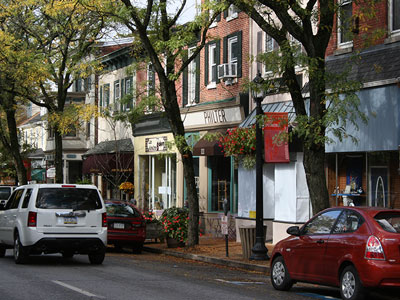
Historic Kennett Square
The Small Business Response Fund is a partnership to assist local businesses in response to the COVID-19 epidemic.
Kennett Square Borough has a façade grant prgram.

West Chester BID
Keystone Façade Grant Funding
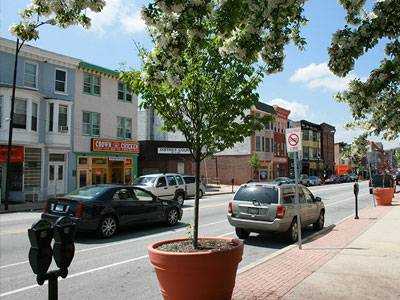
Coatesville City adopted LERTA (Local Economic Revitalization Tax Assistance) to spur economic development.
Coatesville City has a "Green Tape" policy of working with developers so as to not hinder new business by providing guidance and information navigating the city's regulations and permitting processes.

Lancaster City adopted LERTA (Local Economic Revitalization Tax Assistance) to spur economic development.


